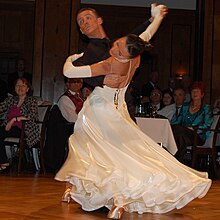
Viennese waltz (German: Wiener Walzer) is a genre of ballroom dance. At least four different meanings are recognized. In the historically first sense, the name may refer to several versions of the waltz, including the earliest waltzes done in ballroom dancing, danced to the music of Viennese waltz.
What is now called the Viennese waltz is the original form of the waltz. It was the first ballroom dance performed in the closed hold or "waltz" position. The dance that is popularly known as the waltz is actually the English or slow waltz, danced at approximately 90 beats per minute with 3 beats to the bar (the international standard of 30 measures per minute), while the Viennese waltz is danced at about 180 beats (58-60 measures) per minute. To this day however, in Germany, Austria, Scandinavia, and France, the words Walzer (German), vals (Danish, Norwegian, and Swedish), and valse (French) still implicitly refer to the original dance and not the slow waltz.
The Viennese waltz is a rotary dance where the dancers are constantly turning either toward the leader's right (natural) or toward the leader's left (reverse), interspersed with non-rotating change steps to switch between the direction of rotation.
As the waltz evolved, some of the versions that were done at about the original fast tempo came to be called specifically "Viennese waltz" to distinguish them from the slower waltzes. In the modern ballroom dance, two versions of Viennese waltz are recognized: International Style and American Style.
Today the Viennese waltz is a ballroom and partner dance that is part of the International Standard division of contemporary ballroom dance. The Waltz Series is a New York membership society devoted to preserving the pre-World War I tradition of Viennese waltz. It organizes a program of dances.[1]
- ^ "Viennese Waltz Dinner Dances". A New York Series. Retrieved 2023-04-08.